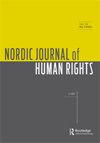语言人权手册
IF 1.2
Q3 POLITICAL SCIENCE
引用次数: 0
摘要
语言人权手册》由托芙-斯库特纳布-坎加斯(Tove Skutnabb-Kangas)和罗伯特-菲利普森(Robert Phillipson)两位著名的语言权利学者主编,介绍了与本卷编者和大多数作者所称的 "语言人权 "研究相关的各种方法、问题、政策和世界各国的案例研究。例如,这一概念意味着儿童,无论是土著儿童还是移民儿童,都有不可剥夺的权利在小学学习他们父母或祖先的语言。值得注意的是,语言人权的支持者通常主张使用密集的语言沉浸式课程来教授儿童语言,因为语言教育专家普遍认为这种方法能提供最佳的学习环境,以达到语言流利和保持语言活力的目的,尤其是对土著儿童而言。通常情况下,浸入式教学意味着建立 "语言巢",让儿童和语言初学者向精通语言者(通常是部落长老)学习。最初,新西兰的毛利长老们建立了 "语巢",希望教孩子们学习自己的母语。随后,夏威夷和世界各地的其他土著群体,包括俄克拉荷马州的切诺基人,都采用了这种模式。语言人权手册》讨论了语言权利的各种方法(如国际法、政治理论、经济政策、(去)殖民化、教育政策等),并介绍了世界各国学者、法学家、活动家、官员以及国家和土著议会、政府和国际组织工作人员实施或侵犯语言权利的大量案例研究。两位编者以及本书中的许多作者似乎都赞同这样一种观点,即语言少数群体(包括本地人和移民)的语言权利是广泛的、绝对的和不可剥夺的(因此在 "权利 "之前使用了 "人权 "这一修饰词)。因此,举例来说,他们经常维护所有少数民族儿童通过某种母语教学计划在小学学习其父母和祖先的语言的权利。然而,尽管这是一个有价值的目标,但它仍然是一个理想的目标,主要是因为在有大量不同移民儿童就读的学校里教授几十种语言涉及到后勤和教学问题,例如,在奥斯陆的学校里有 120 多种语言;在哥德堡的学校里,可以在小学生中找到 75 种语言;或者在法罗群岛的学校里,有大约 300 名来自 50 个不同国家的移民儿童。当然,这不应成为学校不提供任何双语教育计划的借口,特别是对于广泛使用的移民语言,如阿拉伯语、土耳其语、乌尔都语、波兰语等,斯堪的纳维亚半岛的学校里有成千上万(如果不是成百上千的话)的儿童使用这些语言。本文章由计算机程序翻译,如有差异,请以英文原文为准。
The handbook of linguistic human rights
The handbook of linguistic human rights, edited by Tove Skutnabb-Kangas and Robert Phillipson, two eminent language rights scholars, presents a variety of approaches, issues, policies, and case studies in countries from around the world related to the study of what the editors and most of the authors in this volume call ‘linguistic human rights.’ This concept intails, for example, that children, indigenous and immigrant alike, have the inalienable right to learn their parents’ or ancestor’s languages in elementary school. Notably, proponents of linguistic human rights often advocate for the use of intensive language immersion programs to teach languages to children as this method is widely believed by experts in language education to offer the best learning environment to achieve fluency and keep the language alive, especially for indigenous children. Often, immersion means the creation of ‘language nests,’ where children and language beginners learn from proficient speakers, usually tribal elders. Initially, language nests were established in New Zealand by Māori elders who wished to teach children their native language. This model was subsequently adopted in Hawaii and by other indigenous groups throughout the world, including the Cherokee in Oklahoma. The Handbook of Linguistic Human Rights discusses approaches to language rights (e.g., in international law, political theory, economic policy, (de)coloniality, educational policy, etc.) and presents numerous case studies in countries from around the world where language rights are implemented or violated by scholars, jurists, activists, officers and staff at national and indigenous parliaments, governments and international organizations. Both editors, as well as many of the authors in this book, appear to subscribe to the notion that the language rights of linguistic minorities (both local and immigrant) are broad, absolute, and inalienable (hence the use of the qualifier ‘human’ before ‘rights’). Thus, for example, they often uphold the right of allminority children to learn their parents’ and ancestors’ language(s) in elementary school through some sort of mother tongue medium of instruction program. Yet, although this is a worthwhile goal, it remains an aspirational one, mainly because of the logistical and pedagogical problems involved in teaching dozens of languages in schools attended by large and diverse populations of immigrant children, for example, in the Oslo schools where more than 120 languages are spoken; in the Gothenburg schools where 75 languages could be traced among primary school children; or in the schools of the Faroe Islands where there are about 300 immigrant children from some 50 different countries. This, of course, should not be used as an excuse for not providing any bilingual education programs in the schools, especially as regards widely spoken immigrant languages such as Arabic, Turkish, Urdu, Polish, etc., which are spoken by tens (if not hundreds) of thousands of children in the schools of Scandinavia
求助全文
通过发布文献求助,成功后即可免费获取论文全文。
去求助
来源期刊

Nordic Journal of Human Rights
POLITICAL SCIENCE-
CiteScore
1.00
自引率
25.00%
发文量
29
期刊介绍:
The Nordic Journal of Human Rights is the Nordic countries’ leading forum for analyses, debate and information about human rights. The Journal’s aim is to provide a cutting-edge forum for international academic critique and analysis in the field of human rights. The Journal takes a broad view of human rights, and wishes to publish high quality and cross-disciplinary analyses and comments on the past, current and future status of human rights for profound collective reflection. It was first issued in 1982 and is published by the Norwegian Centre for Human Rights at the University of Oslo in collaboration with Nordic research centres for human rights.
 求助内容:
求助内容: 应助结果提醒方式:
应助结果提醒方式:


